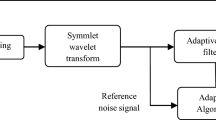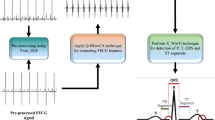Abstract
Birth defect-related demise is mainly due to congenital heart defects. In the earlier stage of pregnancy, fetus problem can be identified by finding information about the fetus to avoid stillbirths. The gold standard used to monitor the health status of the fetus is by Cardiotachography(CTG), cannot be used for long durations and continuous monitoring. There is a need for continuous and long duration monitoring of fetal ECG signals to study the progressive health status of the fetus using portable devices. The non-invasive method of electrocardiogram recording is one of the best method used to diagnose fetal cardiac problem rather than the invasive methods.The monitoring of the fECG requires development of a miniaturized hardware and a efficient signal processing algorithms to extract the fECG embedded in the mother ECG. The paper discusses a prototype hardware developed to monitor and record the raw mother ECG signal containing the fECG and a signal processing algorithm to extract the fetal Electro Cardiogram signal. We have proposed two methods of signal processing, first is based on the Least Mean Square (LMS) Adaptive Noise Cancellation technique and the other method is based on the Wavelet Transformation technique. A prototype hardware was designed and developed to acquire the raw ECG signal containing the mother and fetal ECG and the signal processing techniques were used to eliminate the noises and extract the fetal ECG and the fetal Heart Rate Variability was studied. Both the methods were evaluated with the signal acquired from a fetal ECG simulator, from the Physionet database and that acquired from the subject. Both the methods are evaluated by finding heart rate and its variability, amplitude spectrum and mean value of extracted fetal ECG. Also the accuracy, sensitivity and positive predictive value are also determined for fetal QRS detection technique. In this paper adaptive filtering technique uses Sign-sign LMS algorithm and wavelet techniques with Daubechies wavelet, employed along with de noising techniques for the extraction of fetal Electrocardiogram.Both the methods are having good sensitivity and accuracy. In adaptive method the sensitivity is 96.83, accuracy 89.87, wavelet sensitivity is 95.97 and accuracy is 88.5. Additionally, time domain parameters from the plot of heart rate variability of mother and fetus are analyzed.
































Similar content being viewed by others
References
Xu-Wilson, M., Carlson, E., Cheng, L., and Vairavan, S., Spatial Filtering and Adaptive Rule Based Fetal Heart Rate Extraction from Abdominal Fetal ECG Recordings. Comput. Cardiol. 40:197–200, 2003.
Kim, C.-M., Park, H.-M., Kim, T., Choi, Y.-K., and Lee, S.-Y., FPGA Implementation of ICA Algorithm for Blind Signal Separation and Adaptive Noise Canceling. IEEE Trans. Neural Netw. 14(5):1038–1046, 2003.
Karvounis, E.C., Tsipouras, M.G., Fotiadis, D.I., and Naka, K.K., An Automated Methodology for Fetal Heart Rate Extraction from the Abdominal Electrocardiogram. IEEE Trans. Inf. Technol. Biomed. 11(6):628–638, 2006.
Ye, Y., Zhang, Z.-L., Zeng, J., and Peng, L., A fast and adaptive ICA algorithm with its application to fetal electrocardiogram extraction. Appl. Math. Comput. 205:799–806, 2008.
Shadaydeh, M., Xiao, Y., and Ward, R. K., Extraction of Fetal ECG Using Adaptive Volterra Filters. 16th European Signal Processing Conference (EUSIPCO 2008), 2008.
Prasad, D. V., and Swarnalatha, R., A New Method of Extraction of FECG from Abdominal Signal. 13th International Conference on Biomedical Engineering, IFMBE, 23, 98–100, 2009.
Sameni, R.C.G., A review of fetal ECG signal processing; issues and promising directions. Open Pacing Electrophysiol. Ther. J. 3:4–20, 2010.
Ali, M.A.S., and Zeng, X.P., A Novel Technique for Extraction Foetal Electrocardiogram using Adaptive Filtering and Simple Genetic Algorithm. Am. J. Biostat. 1(2):75–81, 2010.
Swarnalatha, R., and Prasad, D. V., Maternal ECG Cancellation in Abdominal Signal Using ANFIS and Wavelets, http://scialert.net/fulltext/?doi=jas.2010.868.877&org=11, 2010.
Arunkumar, N., Ramkumar, K., Venkatraman, V., Abdulhay, E., Fernandes, S.L., Kadry, S., and Segal, S., Classification of focal and non focal EEG using entropies. Pattern Recogn. Lett. 94:112–117, 2017.
Fernandes, S.L., Gurupur, V.P., Sunder, N.R., Arunkumar, N., and Kadry, S., A novel nonintrusive decision support approach for heart rate measurement. Pattern Recogn. Lett., 2017. https://doi.org/10.1016/j.patrec.2017.07.002.
Wu, S., Shen, Y., Zhou, Z., Lin, L., Zeng, Y., and Gao, X., Research of fetal ECG extraction using wavelet analysis and adaptive filtering. Comput. Biol. Med. 43:1622–1627, 2013.
Prasanth, K., Paul, B., and Balakrishna, A.A., Fetal ECG Extraction Using Adaptive Filters. Int. J. Adv. Res. Electr. Electron. Instrument. Eng. 2(4):1483–1487, 2013.
Arunkumar, N., Ram Kumar, K., and Venkataraman, V., Automatic detection of epileptic seizuresusing permutation entropy, Tsallis entropy and Kolmogorov complexity. J. Med. Imag. Health Inform. 6(2):526–531, 2016.
Samuel, O.W., Zhou, H., Li, X., Wang, H., Zhang, H., Sangaiah, A.K., and Li, G., Pattern recognition of electromyography signals based on novel time domain features for amputees' limb motion classification. Comput. Electr. Eng., 2017. https://doi.org/10.1016/j.compeleceng.2017.04.003.
Panigrahy, D., and Dastidar, A., Extraction. Noise Cancellation And Monitoring Of Fetal Electrocadiogram. Int. J. Electr. Electron. Eng. 3(2):108–112, 2013.
Rai, H.M., Trivedi, A., and Shukla, S., ECG signal processing for abnormalities detection using Multi–resolution Wavelet transform & Artificial Neural Network classifier. Measurement:3238–3246, 2013. https://doi.org/10.1016/j.measurement.2013.05.021.
Niknazar, M., Rivet, B., and Jutten, C., Fetal ECG Extraction by Extended State Kalman Filtering Based on Single-Channel Recordings. Biomed. Eng. IEEE Trans. 60(5):1345–1352, 2013.
Razavipour, F., Haghpanahi, M., and Sameni, R., Fetal QRS complex detection using semi-blind source separationframework. Comput. Cardiol. Conf:181–184, 2013.
Kumar, A., et al., A Novel Approach in ECG Signal Processing Signal and Image Processing in Medical Applications. Springer Briefs in Forensic and Medical Bioinformatics, 2016. https://doi.org/10.1007/978-981-10-0690-6_2.
Zhang, N., Zhang, J., Li, H., Mumini, O.O., Samuel, O.W., Ivanov, K., and Wang, L., A Novel Technique for Fetal ECG Extraction Using Single-Channel Abdominal Recording. Sensors. 17:457, 2017. https://doi.org/10.3390/s17030457.
Karvounis, E.C., Papaloukas, C., Fotiadis, D.I., and Michalis, L.K., Fetal heart rate extraction from composite Maternal ECG using complex wavelet transform. Comput. Cardiol. https://doi.org/10.1109/CIC.2004.1443044.
Medhane, D.V., and Sangaiah, A.K., ESCAPE: Effective Scalable Clustering Approach for Parallel Execution of continuous position-based queries in position monitoring applications. IEEE Trans. Sustain. Comput., 2017. https://doi.org/10.1109/TSUSC.2017.2690378.
Liang, W., Tang, M., Jing, L., Sangaiah, A.K., and Huang, Y., SIRSE: A secure identity recognition scheme based on electroencephalogram data with multi-factor feature. Comput. Electr. Eng., 2017. https://doi.org/10.1016/j.compeleceng.2017.05.001.
Khanduzi, R., Peyghami, M.R., and Sangaiah, A.K., Data envelopment analysis and interdiction median problem with fortification for enabling IoT technologies to relieve potential attacks. Futur. Gener. Comput. Syst., 2017. https://doi.org/10.1016/j.future.2017.08.056.
Panigrahy, D., and Sahu, P.K., Extraction of fetal electrocardiogram (ECG) by extended state Kalman filtering and adaptive neuro-fuzzy inferencesystem (ANFIS) based on single channel abdominalrecording. Indian Acad. Sci. 40(4):1091–1104, 2015.
Lamesgin, G., Kassaw, Y., and Assefa, D., Extraction of Fetal ECG from Abdominal ECG and Heart Rate Variability Analysis. Afro-European Conference for Industrial Advancement, 2015. https://doi.org/10.1007/978-3-319-13572-4_5. Part of the Advances in Intelligent Systems and Computing book series (AISC, volume 334).
Ignatius Uvansiya, K., and Parveen Banu, S., Extraction of Non Invasive Fetal ECG Using Stationary Wavelet Transform and Extended Kalman Filter. Int. J. Adv. Inform. Sci. Technol. 4(2):491–496, 2015. 10.15693/ijaist/2015.v4i2.
Yao, S., Sangaiah, A. K., Zheng, Z., and Wang, T., Sparsity estimation matching pursuit algorithm based on restricted isometry property for signal reconstruction. Future Generation Computer Systems, 2017. https://doi.org/10.1016/j.future.2017.09.034.
Gupta, P., Sharma, K.K., and Joshi, S.D., Fetal heart rate extraction from abdominal electrocardiograms through multivariate empirical mode decomposition. Comput. Biol. Med., 2016. https://doi.org/10.1016/j.compbiomed.2015.11.007.
Lima-Herrera, S. L., Alvarado-Serrano, C., and Hernandez-Rodriguez, P. R., Fetal ECG extraction based on adaptive filters and Wavelet Transform: Validation and application in fetal heart rate variability analysis. 13th International Conference on Electrical Engineering, Computing Science and Automatic Control (CCE), 2016. https://doi.org/10.1109/ICEEE.2016.7751243.
Khandve, M., Khude, P., Ingale, A., and Wanare, A., Fetal ECG Extraction & Analysis Using Wavelet Transform. Int. J. Res. Appl. Sci. Eng. Technol. 4(IV):274–277, 2016.
Zhang, N., Zhang, J., Li, H., Mumini, O.O., Samuel, O.W., Ivanov, K., and Wang, L., A Novel Technique for Fetal ECG Extraction Using Single-Channel Abdominal Recording. Sensors, 2017. https://doi.org/10.3390/s17030457.
Ahmad, A.A., Kuta, A.I., and Loko, A.Z., Analysis of Abdominal ECG Signal for FetalHeart Rate Estimation Using Adaptive Filtering Technique. Int. J. Image Graph. Signal Process., 2017. https://doi.org/10.5815/ijigsp.2017.02.03.
Li, R., Frasch, M.G., and Wu, H.-T., Efficient Fetal-Maternal ECG Signal Separation from Two Channel Maternal Abdominal ECG via Diffusion-Based Channel Selection. Front. Physiol., 2017. https://doi.org/10.3389/fphys.2017.00277.
Su, L., and Wu, H.-T., Extract Fetal ECG from Single-LeadAbdominal ECG by De-Shape ShortTime Fourier Transform and NonlocalMedian. Front. Appl. Math. Stat., 2017. https://doi.org/10.3389/fams.2017.00002.
Diniz, P. S. R., Adaptive filtering, algorithm and practical application. Engineering Signals & Communication, The Springer International Series in Engineering and Computer Science, 2002.
Orfanidis S. J. Optimum Signal Processing an Introduction. New York: McGraw-Hill Publishing Company, 2007.
Saritha, C., Sukanya, V., and Narasimha Murthy, Y., ECG Signal Analysis Using Wavelet Transforms. Bulg. J. Phys. 35:68–77, 2008.
Lin, G.H., Chang, Y.H., and Lin, K.P., Comparison of Heart Rate Variability Measured by ECG in Different Signal Lengths. J. Med. Biol. Eng. 25(2):67–71, 2005.
Wu, S., Shena, Y., Zhou, Z., and Lin, L., Yanjun Zeng, Xiaofeng Gao, Research of fetal ECG extraction using wavelet analysis and adaptive filtering. Comput. Biol. Med. 43:622–1627, 2013.
Rajesh, P., Umamaheswari, K., and Naveen Kumar, V., A Novel Approach of Fetal ECG Extraction Using Adaptive Filtering. Int. J. Inf. Sci. Intell. Syst. 3(2):55–70, 2014.
Clifford, G.D., Silva, I., Behar, J., and Moody, G.B., Non-invasive fetal ECG analysis. Physiol. Meas. 35(8):1521–1536, 2014. https://doi.org/10.1088/0967-3334/35/8/1521.
Author information
Authors and Affiliations
Corresponding author
Additional information
This article is part of the Topical Collection on Image & Signal Processing
Rights and permissions
About this article
Cite this article
Sutha, P., Jayanthi, V. Fetal Electrocardiogram Extraction and Analysis Using Adaptive Noise Cancellation and Wavelet Transformation Techniques. J Med Syst 42, 21 (2018). https://doi.org/10.1007/s10916-017-0868-3
Received:
Accepted:
Published:
DOI: https://doi.org/10.1007/s10916-017-0868-3




